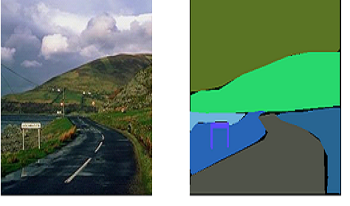References
1KrizhevskyA.SutskeverI.HintonG.2012Imagenet classification with deep convolutional neural networksAdv. Neural Inf. Process. Syst.25109711051097–10510.1145/3065386
2DengJ.DongW.SocherR.LiL.LiK.Fei-FeiL.Imagenet: A large-scale hierarchical image database2009 IEEE Conf. on Computer Vision and Pattern Recognition2009IEEEPiscataway, NJ248255248–5510.1109/CVPR.2009.5206848
3GirshickR.Fast r-cnnProc. IEEE Int’l. Conf. on Computer Vision2015IEEEPiscataway, NJ144014481440–810.1109/ICCV.2015.169
4RedmonJ.DivvalaS.GirshickR.FarhadiA.You only look once: Unified, real-time object detectionProc. IEEE Conf. on Computer Vision and Pattern Recognition2016IEEEPiscataway, NJ779788779–8810.1109/CVPR.2016.91
5RonnebergerO.FischerP.BroxT.U-net: Convolutional networks for biomedical image segmentationInt’l. Conf. on Medical Image Computing and Computer-assisted Intervention2015SpringerCham234241234–4110.1007/978-3-319-24574-4_28
6JégouS.DrozdzalM.VazquezD.RomeroA.BengioY.The one hundred layers tiramisu: Fully convolutional densenets for semantic segmentationProc. IEEE Conf. on Computer Vision and Pattern Recognition Workshops2017IEEEPiscataway, NJ111911–910.1109/CVPRW.2017.156
7RajpalS.SadhyaD.DeK.RoyP. P.RamanB.Eai-net: Effective and accurate iris segmentation networkInt’l. Conf. on Pattern Recognition and Machine Intelligence2019SpringerCham442451442–5110.1007/978-3-030-34869-4_48
8OsadebeyM.AndersenH. K.WaalerD.FossaaK.MartinsenA.PedersenM.2021Three-stage segmentation of lung region from ct images using deep neural networksBMC Med. Imaging211191–1910.1186/s12880-021-00640-1
9ZhouB.ZhaoH.PuigX.XiaoT.FidlerS.BarriusoA.TorralbaA.2019Semantic understanding of scenes through the ade20k datasetInt. J. Comput. Vis.127302321302–2110.1007/s11263-018-1140-0
10HeK.ZhangX.RenS.SunJ.Deep residual learning for image recognitionProc. IEEE Conf. on Computer Vision and Pattern Recognition2016IEEEPiscataway, NJ770778770–810.1109/CVPR.2016.90
11HuangG.LiuZ.Van Der MaatenL.WeinbergerK. Q.Densely connected convolutional networksProc. IEEE Conf. on Computer Vision and Pattern Recognition2017IEEEPiscataway, NJ470047084700–810.1109/CVPR.2017.243
12SimonyanK.ZissermanA.
13SzegedyC.LiuW.JiaY.SermanetP.ReedS.AnguelovD.ErhanD.VanhouckeV.RabinovichA.Going deeper with convolutionsProc. IEEE Conf. on Computer Vision and Pattern Recognition2015IEEEPiscataway, NJ191–910.1109/CVPR.2015.7298594
14TanM.LeQ.Efficientnet: Rethinking model scaling for convolutional neural networksInt’l. Conf. on Machine Learning2019PMLRLong Beach, California610561146105–1410.48550/arXiv.1905.11946
15LiuZ.MaoH.WuC.-Y.FeichtenhoferC.DarrellT.XieS.
16DosovitskiyA.BeyerL.KolesnikovA.WeissenbornD.ZhaiX.UnterthinerT.DehghaniM.MindererM.HeigoldG.GellyS.UszkoreitSJ.
17LiuZ.LinY.CaoY.HuH.WeiY.ZhangZ.LinS.GuoB.Swin transformer: Hierarchical vision transformer using shifted windowsProc. IEEE/CVF Int’l. Conf. on Computer Vision2021IEEEPiscataway, NJ100121002210012–2210.1109/ICCV48922.2021.00986
18TouvronH.CordM.DouzeM.MassaF.SablayrollesA.JégouH.Training data-efficient image transformers & distillation through attentionInt’l. Conf. on Machine Learning2021PMLRCambridge, MA103471035710347–57
19DodgeS.KaramL.Understanding how image quality affects deep neural networks2016 Eighth Int’l. Conf. on Quality of Multimedia Experience (QoMEX)2016IEEEPiscataway, NJ161–610.1109/QoMEX.2016.7498955
20DodgeS.KaramL.A study and comparison of human and deep learning recognition performance under visual distortions2017 26th Int’l. Conf. on Computer Communication and Networks (ICCCN)2017IEEEPiscataway, NJ171–710.1109/ICCCN.2017.8038465
21RoyP.GhoshS.BhattacharyaS.PalU.
22HendrycksD.DietterichT.Benchmarking neural network robustness to common corruptions and perturbationsProc. of the Int’l. Conf. on Learning Representations2019
23HendrycksD.ZhaoK.BasartS.SteinhardtJ.SongD.Natural adversarial examples.Proc. IEEE/CVF Int’l. Conf. on Computer Vision2021IEEEPiscataway, NJ152621527115262–7110.1109/CVPR46437.2021.01501
24HendrycksD.BasartS.MuN.KadavathS.WangF.DorundoE.DesaiR.ZhuT.ParajuliS.GuoM.SongD.The many faces of robustness: A critical analysis of out-of-distribution generalization.Proc. IEEE/CVF Int’l. Conf. on Computer Vision2021IEEEPiscataway, NJ834083498340–910.1109/ICCV48922.2021.00823
25ZhangR.IsolaP.EfrosA.Colorful image colorizationEuropean Conf. on Computer Vision2016SpringerCham649666649–6610.1007/978-3-319-46487-9_40
26NazeriK.NgE.EbrahimiM.Image colorization using generative adversarial networksInt’l. Conf. on Articulated Motion and Deformable Objects2018SpringerCham859485–9410.1007/978-3-319-94544-6_9
27HalderS.DeK.RoyP.Perceptual conditional generative adversarial networks for end-to-end image colourizationAsian Conf. on Computer Vision2018SpringerCham269283269–8310.1007/978-3-030-20890-5_18
28ShopovskaI.JovanovL.PhilipsW.Rgb-nir demosaicing using deep residual u-net2018 26th Telecommunications Forum (TELFOR)2018IEEEPiscataway, NJ141–410.1109/TELFOR.2018.8611819
29LuoJ.WangJ.2020Image demosaicing based on generative adversarial networkMath. Proble. Eng.202010.1155/2020/7367608
30BuhrmesterV.MünchD.BulatovD.ArensM.Evaluating the impact of color information in deep neural networksIberian Conf. on Pattern Recognition and Image Analysis2019SpringerCham302316302–1610.1007/978-3-030-31332-6_27
31DeK.PedersenM.Impact of colour on robustness of deep neural networksProc. IEEE/CVF Int’l. Conf. on Computer Vision2021IEEEPiscataway, NJ213021–3010.1109/ICCVW54120.2021.00009
32FlachotA.GegenfurtnerK.2021Color for object recognition: hue and chroma sensitivity in the deep features of convolutional neural networksVis. Res.1828910089–10010.1016/j.visres.2020.09.010
33DeK.PedersenM.Effect of hue shift towards robustness of convolutional neural networksProc. IS&T Electronic Imaging: Color Imaging XXVII: Displaying, Processing, Hardcopy, and Applications2022IS&TSpringfield, VA156-1156-6156-1–610.2352/EI.2022.34.15.COLOR-156
34DengY.ManjunathB.ShinH.Color image segmentationProc. 1999 IEEE Computer Society Conf. on Computer Vision and Pattern Recognition19992IEEEPiscataway, NJ446451446–5110.1109/CVPR.1999.784719
35ChenT. Q.LuY.2002Color image segmentation–an innovative approachPattern Recognit.35395405395–40510.1016/S0031-3203(01)00050-4
36KhattabD.EbiedH. M.HusseinA. S.TolbaM. F.2014Color image segmentation based on different color space models using automatic grabcutSci. World J.201410.1155/2014/126025
37KantipudiJ.DubeyS. R.ChakrabortyS.2020Color channel perturbation attacks for fooling convolutional neural networks and a defense against such attacksIEEE Trans. Artif. Intell.1181191181–9110.1109/TAI.2020.3046167
38GeirhosR.RubischP.MichaelisC.BethgeM.WichmannF. A.BrendelW.Imagenet-trained CNNs are biased towards texture; increasing shape bias improves accuracy and robustnessProc. Int’l. Conf. on Learning Representations2019ICLRNew Orleans, LA10.48550/arXiv.1811.12231
39PapernotN.McDanielP.JhaS.FredriksonM.CelikZ. B.SwamiA.The limitations of deep learning in adversarial settings2016 IEEE European Symposium on Security and Privacy (EuroS&P)2016IEEEPiscataway, NJ372387372–8710.1109/EuroSP.2016.36
40CarliniN.WagnerD.Towards evaluating the robustness of neural networks2017 IEEE Symposium on Security and Privacy (sp)2017IEEEPiscataway, NJ395739–5710.1109/SP.2017.49
41TaoriR.DaveA.ShankarV.CarliniN.RechtB.SchmidtL.2020Measuring robustness to natural distribution shifts in image classification.Adv. Neural Inf. Process. Syst.33185831859918583–9910.48550/arXiv.2007.00644
42RauberJ.ZimmermannR.BethgeM.BrendelW.2020Foolbox native: Fast adversarial attacks to benchmark the robustness of machine learning models in pytorch, tensorflow, and jaxJ. Open Source Softw.5260710.21105/joss.02607
43KamannC.RotherC.Benchmarking the robustness of semantic segmentation modelsProc. IEEE/CVF Conf. on Computer Vision and Pattern Recognition2020IEEEPiscataway, NJ882888388828–3810.1109/CVPR42600.2020.00885
44MinaeeS.BoykovY.PorikliF.PlazaA. J.KehtarnavazN.TerzopoulosD.Image segmentation using deep learning: A surveyIEEE Trans. on Pattern Analysis and Machine Intelligence2021IEEEPiscataway, NJ10.1109/TPAMI.2021.3059968
45ZhouB.ZhaoH.PuigX.FidlerS.BarriusoA.TorralbaA.Scene parsing through ade20k datasetProc. IEEE Conf. on Computer Vision and Pattern Recognition2017IEEEPiscataway, NJ633641633–4110.1109/CVPR.2017.544
46
47LongJ.ShelhamerE.DarrellT.Fully convolutional networks for semantic segmentationProc. IEEE Conf. on Computer Vision and Pattern Recognition2015IEEEPiscataway, NJ343134403431–4010.1109/CVPR.2015.7298965
48ZhaoH.ShiJ.QiX.WangX.JiaJ.Pyramid scene parsing networkProc. IEEE Conf. on Computer Vision and Pattern Recognition2017IEEEPiscataway, NJ288128902881–9010.1109/CVPR.2017.660
49XiaoT.LiuY.ZhouB.JiangY.SunJ.Unified perceptual parsing for scene understandingProc. European Conf. on Computer Vision (ECCV)2018SpringerCham418434418–3410.48550/arXiv.1807.10221
50StrudelR.GarciaR.LaptevI.SchmidC.Segmenter: Transformer for semantic segmentationProc. IEEE/CVF Int’l. Conf. on Computer Vision2021IEEEPiscataway, NJ726272727262–7210.1109/ICCV48922.2021.00717
51SuralS.QianG.PramanikS.Segmentation and histogram generation using the hsv color space for image retrievalProc. Int’l. Conf. on Image Processing2002Vol. 2IEEEPiscataway, NJIIIIII–10.1109/ICIP.2002.1040019
52SmithA. R.1978Color gamut transform pairsACM Siggraph Comput. Graph.12121912–910.1145/965139.807361
53PoyntonC. A.A Technical Introduction to Digital Video1996John Wiley & Sons, Inc.175
54PapakiposZ.BittonJ.AugLy: Data augmentations for adversarial robustnessProc. IEEE/CVF Conf. on Computer Vision and Pattern Recognition2022IEEEPiscataway, NJ156163156–6310.48550/arXiv.2201.06494
55FarupI.GattaC.RizziA.2007A multiscale framework for spatial gamut mappingIEEE Trans. Image Process.16242324352423–3510.1109/TIP.2007.904946
56BuslaevA.IglovikovV. I.KhvedchenyaE.ParinovA.DruzhininM.KalininA.2020Albumentations: fast and flexible image augmentationsInformation1112510.3390/info11020125

 Find this author on Google Scholar
Find this author on Google Scholar Find this author on PubMed
Find this author on PubMed
 Open access
Open access